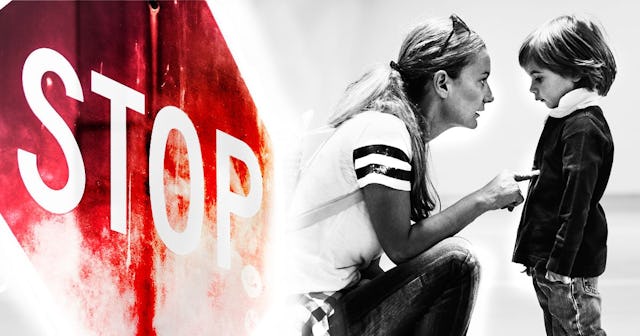Telling Our Kids 'Don't Do That' And 'Stop' Doesn't Work

I have three children. Some of them are neurotypical, some of them are not. I’ve worked with neurodiverse kids for 15 years, and have learned some things that tend to work (and not) when trying to get them to do what I want.
Things I often hear from parents when I’m out:
“Don’t touch that.”
“Stop.”
“Quit.”
“Don’t do that!”
And the thing I automatically think is, “Don’t touch what? Don’t do what? Stop what?” This is where my little trick comes into play.
See, adults can think of the opposite of things pretty well. The opposite of up is down. The opposite of in is out. The opposite of hot is cold. But with little kids, their brains don’t process things that way. For one, it’s developmentally inappropriate (which is why you can find so many toddler books on opposites, or puzzle games, or any number of other learning toys pertaining to opposites). Combine that with a little bit of neurodiversity and things can get quite challenging.
Juanmonino/Getty
So if we hear someone say, “Don’t stand up,” we automatically think, “Then I should stay seated.” They are two sides of the same coin. But this is not the case for young kiddos, or kiddos with neurodiversity. That takes too many cognitive steps to determine that (a) oh, I’m not doing what she wants, (b) this action is the opposite of that action, and (c) I should now do the opposite.
That’s a lot of step by step problem solving! Not to mention that if the person’s request is super vague (i.e. “Stop that!”), you can add in there all the plethora of various things you might be doing that you’re now supposed to figure the opposite out of now. Stop … eating? Stop … twirling my hair? Stop … humming? I’m doing a lot of things, so exactly which one am I supposed to stop?!
Here’s a better solution: Tell your kiddo what you want them to do, not what you don’t want them to do. Here are a few examples:
My child is hitting me because slapping is suddenly funny (thanks, preschool), and I say, “Nice hands only, please.”
My kid is screaming inside the house, and I say, “Inside voices, please, or go outside to yell.”
I can see my oldest child about to pounce on my middle child, and I say, “Make good choices, please.”
It is so much easier for the kid when they know exactly what is expected of them. That takes out all the guess work. Additionally, I’ve kept the tone of the exchange more neutral/positive, so they are less likely to get their fight or flight mode to kick in (because when that happens, all of our problem-solving skills go right out the window).
So that’s it. Instead of vaguely telling your child what you don’t want them to do, tell them instead what you do want from them.
Pro tip: Notice that I didn’t say ask your child, I said tell them. If you ask them “Honey, can you use nice hands, please?” then they can easily say, “No.” After all, no is a viable answer to a question. So don’t give that as an option. Tell them in a matter of fact voice what you expect of them, because more often than not, asking will just end up frustrating both of you.
By approaching our requests in a different way, we can be clear with our kids — both neurotypical and neurodiverse — and let them know exactly what we want from them. It sounds simple, but you’ll be surprised at how big a difference such a small change can make.
This article was originally published on